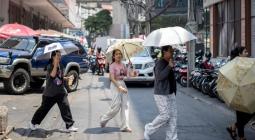Climate breakdown made southern Asia heatwave at least 2C hotter, study finds

A searing heatwave in parts of southern Asia in April was made at least 30 times more likely by climate breakdown, according to a study by international scientists.
Unusually high temperatures of up to 45C (113F) were recorded last month in monitoring stations in parts of India, Bangladesh, Thailand and Laos.
The heat caused deaths and widespread hospitalisations, damaged roads, sparked fires and led to school closures in the region, the study by the World Weather Attribution group found.
In Thailand, high temperatures mixed with humidity meant some parts of the country felt above 50C (122F). In India, several regions were affected and 13 people died due to the heat at a public event outside Mumbai. The eastern Indian state of West Bengal closed all schools and colleges for a week.
The study found that temperatures were at least 2C (3.6F) hotter in the region because of climate breakdown.
If the global average temperature reaches 2C warmer than pre-industrial times, the April heatwave could occur every one to two years in India and Bangladesh, the study said. Currently, the world is about 1.1C to 1.2C (2F to 2.2F) warmer.
“We see again and again that climate change dramatically increases the frequency and intensity of heatwaves, one of the deadliest weather events there are,” said Friederike Otto, a senior climate scientist at Imperial College London and one of the study’s authors
Heat action plans — which are government-run and funded and aim to help people deal with extreme heat through awareness programmes, training for healthcare workers and affordable cooling methods — need to be implemented faster in India and other heat-affected countries, the study’s authors said.
“Access to healthcare and to cooling solutions like fans and air conditioners is missing for a lot of the population in this region,” said Emmanuel Raju, the director of the University of Copenhagen’s Centre for Disaster Research and another of the study’s authors.
Raju said heat affected the poorest people and people whose work required them to be outside – farmers, street vendors and construction workers – the most.
“It’s important to talk about who can cope and adapt to heat,” he said. “Many are still recovering from the pandemic, and from past heatwaves and cyclones, which leaves them trapped in a vicious cycle.”
The southern Asian region is considered among the most vulnerable to climate change in the world, according to numerous global climate studies.
Scientists say drastic action to reduce carbon dioxide emissions immediately is the only solution.
“Heatwaves will become more common, temperatures will rise even more and the number of hot days will increase and become more frequent” if we continue to pump greenhouse gases into the atmosphere, said Chaya Vaddhanaphuti, a lecturer at Chiang Mai University in Thailand and a co-author of the study.
cover photo:Women drinking bottles of water in Kolkata, India during the April heatwave. Photograph: Sudipta Das/NurPhoto/Shutterstock







